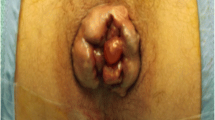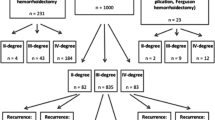Abstract
Background
Traditional treatment of fourth-degree haemorrhoidal disease (HD) is conventional haemorrhoidectomy and is frequently associated with significant pain and morbidity. In recent years, the use of transanal haemorrhoidal dearterialization (THD) for the treatment of HD has increased. The procedure aims to decrease the arterial blood flow to the haemorrhoids. Moreover, since a rectal mucopexy to treat the prolapsing component has become part of the THD technique, this treatment is also indicated for more advanced HD. The aim of this study was to assess the possible role of THD in the treatment of fourth-degree HD.
Methods
All patients with non-fibrotic fourth-degree HD were offered the THD procedure with mucopexy. Excision of skin tags was added to THD and mucopexy, when needed. A specific score was used to assess HD severity, ranging from 0 (no HD) to 20 (worst HD). The mean preoperative score was 18.1 ± 1.8.
Results
Thirty-five consecutive patients (mean age 50.4 ± 13.8 years; 19 men) with fourth-degree HD were prospectively enroled. An average of 6 arteries were identified and transfixed. Mucopexy was achieved with a 3–6 sector plication of rectal mucosa. Mean operating time was 33 ± 12 min. No intraoperative complications were recorded. Postoperative morbidity included 3 (8.6%) haemorrhoidal thromboses (1 requiring surgery) and 2 (5.7%) episodes of bleeding (1 requiring surgical haemostasis). Five patients (14.3%) had urinary retention requiring catheterization. At a median follow-up of 10 months (range 2–28 months), symptoms had resolved or significantly improved in 33 (94%) patients. Nine patients (25.7%) reported irregular bleeding, 3 patients (8.6%) mild anal pain, 4 patients (11.4%) transient anal burning and 4 patients (11.4%) tenesmus. Ten patients (28.6%) experienced some degree of residual prolapse, significant only in 2 (5.7%) who required further surgery. There was no anorectal stenosis, and no faecal incontinence was reported. At a median follow-up of 10 months, the symptomatic score was 2.5 ± 2.5 (P < 0.005).
Conclusion
Transanal haemorrhoidal dearterialization seems to be a safe and effective treatment for fourth-degree HD providing a significant improvement of symptoms for the majority of patients. When present, persisting symptoms are mostly transient, occasional or limited in severity, and only a very few patients require further intervention. Larger series and longer follow-up to further assess the role of THD in this challenging group of pts.


Similar content being viewed by others
References
Maeda Y, Phillips RKS (2009) Open hemorrhoidectomy. In: Khubchandani I, Paonessa N, Khawaja A (eds) Surgical treatment of hemorrhoids. Springer, London, pp 71–76
Metcalf DR, Senagore AJ (2010) Hemorrhoidal surgery. In: Whitlow CB, Beck DE, Margolin DA, Hicks TC, Timmcke AE (eds) Improved outcomes in colon and rectal surgery. Informa Healthcare, Colchester, pp 168–177
Sohn N, Aronoff JS, Cohen FS, Weinstein MA (2001) Transanal hemorrhoidal dearterialization is an alternative to operative hemorrhoidectomy. Am J Surg 182:515–519
Bursics A, Morvay K, Kupcsulik P, Flautner L (2004) Comparison of early and 1-year follow-up results of conventional hemorrhoidectomy and hemorrhoid artery ligation: a randomized study. Int J Colorectal Dis 19:176–180
Dal Monte PP, Tagariello C, Sarago M et al (2007) Transanal haemorrhoidal dearterialisation: nonexcisional surgery for the treatment of haemorrhoidal disease. Tech Coloproctol 11:333–338
Giordano P, Overton J, Madeddu F, Zaman S, Gravante G (2009) Transanal hemorrhoidal dearterialization: a systematic review. Dis Colon Rectum 52:1665–1671
Morinaga K, Hasuda K, Ikeda T (1995) A novel therapy for internal hemorrhoids: ligation of the hemorrhoidal artery with a newly devised instrument (Moricorn) in conjunction with a Doppler flowmeter. Am J Gastroenterol 90:610–613
Aigner F, Bodner G, Conrad F et al (2004) The superior rectal artery and its branching pattern with regard to its clinical influence on ligation techniques for internal hemorrhoids. Am J Surg 187:102–108
Ratto C, Donisi L, Parello A, Litta F, Doglietto GB (2010) Evaluation of transanal hemorrhoidal dearterialization as a minimally invasive therapeutic approach to hemorrhoids. Dis Colon Rectum 53:803–811
Goligher JC, Leacock AG, Brossy JJ (1955) The surgical anatomy of the anal canal. Br J Surg 43:51–61
Bleday R, Pena JP, Rothenberger DA, Goldberg SM, Buls JG (1992) Symptomatic hemorrhoids: current incidence and complications of operative therapy. Dis Colon Rectum 35:477–481
Arbman G, Krook H, Haapaniemi S (2000) Closed vs. open hemorrhoidectomy–is there any difference? Dis Colon Rectum 43:31–34
Sayfan J (2001) Complications of Milligan-Morgan hemorrhoidectomy. Dig Surg 18:131–133
Yano T, Matsuda Y, Asano M et al (2009) The outcome of postoperative hemorrhaging following a hemorrhoidectomy. Surg Today 39:866–869
Chen JS, You JF (2010) Current status of surgical treatment for hemorrhoids–systematic review and meta-analysis. Chang Gung Med J 33:488–500
Stolfi VM, Sileri P, Micossi C et al (2008) Treatment of hemorrhoids in day surgery: stapled hemorrhoidopexy vs Milligan-Morgan hemorrhoidectomy. J Gastrointest Surg 12:795–801
Altomare DF (2009) Stapled hemorrhoidopexy. In: Khubchandani I, Paonessa N, Khawaja A (eds) Surgical treatment of hemorrhoids. Springer, London, pp 87–94
Ravo B, Amato A, Bianco V et al (2002) Complications after stapled hemorrhoidopexy: can they be prevented? Tech Coloproctol 6:83–88
Ripetti V, Caricato M, Arullani A (2002) Rectal perforation, retropneumoperitoneum, and pneumomediastinum after stapling procedure for prolapsed hemorrhoids: report of a case and subsequent considerations. Dis Colon Rectum 45:268–270
Blouhos K, Vasiliadis K, Tsalis K et al (2007) Uncontrollable intra-abdominal bleeding necessitating low anterior resection of the rectum after stapled hemorrhoidopexy: report of a case. Surg Today 37:254–257
Pescatori M, Gagliardi G (2008) Postoperative complications after procedure for prolapsed hemorrhoids (PPH) and stapled transanal rectal resection (STARR) procedures. Tech Coloproctol 12:7–19
van Wensen RJ, van Leuken MH, Bosscha K (2008) Pelvic sepsis after stapled hemorrhoidopexy. World J Gastroenterol 14:5924–5926
Cirocco WC (2008) Life threatening sepsis and mortality following stapled hemorrhoidopexy. Surgery 143:824–829
Augustin G, Smud D, Kinda E et al (2009) Intra-abdominal bleeding from a seromuscular tear of an ascending rectosigmoid intramural hematoma after stapled hemorrhoidopexy. Can J Surg 52:E14–E15
Dowden JE, Stanley JD, Moore RA (2010) Obstructed defecation after stapled hemorrhoidopexy: a report of four cases. Am Surg 76:622–625
Jayaraman S, Colquhoun PH, Malthaner RA (2007) Stapled hemorrhoidopexy is associated with a higher long-term recurrence rate of internal hemorrhoids compared with conventional excisional hemorrhoid surgery. Dis Colon Rectum 50:1297–1305
Tjandra JJ, Chan MK (2007) Systematic review on the procedure for prolapse and hemorrhoids (stapled hemorrhoidopexy). Dis Colon Rectum 50:878–892
Giordano P, Gravante G, Sorge R, Ovens L, Nastro P (2009) Long-term outcomes of stapled hemorrhoidopexy vs conventional hemorrhoidectomy: a meta-analysis of randomized controlled trials. Arch Surg 144:266–272
Zacharakis E, Kanellos D, Pramateftakis MG et al (2007) Long-term results after stapled haemorrhoidopexy for fourth-degree haemorrhoids: a prospective study with median follow-up of 6 years. Tech Coloproct 11:144–147
Ceci F, Picchio M, Palimento D et al (2006) Long-term outcome of stapled hemorrhoidectomy for Grade III and Grade IV hemorrhoids. Dis Colon Rectum 21:166–171
Ortiz H, Marzo J, Armendariz P (2002) Randomized clinical trial of stapled haemorrhoidopexy versus conventional diathermy haemorrhoidectomy. Br J Surg 89:1376–1381
Ortiz H, Marzo J, Armendariz P et al (2005) Stapled haemorrhoidopexy vs. diathermy excision for fourth-degree hemorrhoids: a randomized, clinical trial and review of the literature. Dis Colon Rectum 48:809–815
Boccasanta P, Capretti PG, Venturi M et al (2001) Randomised controlled trial between stapled circumferential mucosectomy and conventional circular haemorrhoidectomy in advanced haemorrhoids with external mucosal prolapse. Am J Surg 182:64–68
Infantino A, Bellomo R, Dal Monte PP et al (2010) Transanal haemorrhoidal artery echodoppler ligation and anopexy (THD) is effective for II and III degree haemorrhoids: a prospective multicentric study. Colorectal Dis 12:804–809
Author information
Authors and Affiliations
Corresponding author
Rights and permissions
About this article
Cite this article
Ratto, C., Giordano, P., Donisi, L. et al. Transanal haemorrhoidal dearterialization (THD) for selected fourth-degree haemorrhoids. Tech Coloproctol 15, 191–197 (2011). https://doi.org/10.1007/s10151-011-0689-1
Received:
Accepted:
Published:
Issue Date:
DOI: https://doi.org/10.1007/s10151-011-0689-1




